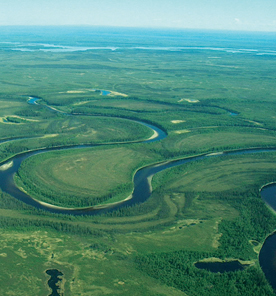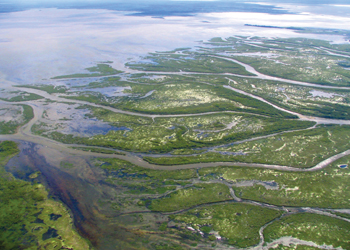IN THE FALL OF 2003, when Jonathan Pundsack was just settling in as coordinator of a large, national scientific investigation of the Arctic’s complex hydrological system, neither he nor anyone else involved in the effort would have imagined that the biggest, single component of the region’s water system would be fast disappearing from the face of the Earth as the program drew to a close.
Satellite image of Cape Fear River in North Carolina from NASA's Sea-viewing Wide Field-of-view Sensor (SeaWiFS).
Photo by Mark Dornblaser, USGS. |
The big meltdown, which briefly opened up normally ice-clogged sea routes for the first time in recorded history, has served as a wake-up call to both scientists and the public at large. The top of our world is losing its icy grip.
Given the circumstances, it was fitting, then, that the National Science Foundation’s Arctic Community-wide Hydrologic Analysis and Monitoring Program or Arctic CHAMP – the study Pundsack has coordinated for over five years – had dozens of scientists under 22 separate research grants poised to investigate the polar region’s unnerving metamorphosis.
“We’ve made a lot of advances in characterizing some of the changes taking place in the pan-Arctic with respect to freshwater on the land, in the atmosphere, and in the ocean,” says Pundsack of the Complex Systems Research Center. The program has officially ended but Pundsack’s management office will continue to synthesize data and coordinate outreach and education components. Moreover, smaller component projects are continuing and a second phase of the overarching program is planned.
The fundamental work of the NSF project, alternatively referred to as the Freshwater Integration study, was to synthesize a large number of interdisciplinary research projects in an effort to better understand the Arctic’s vast water cycle. Research assistant professor Richard Lammers and research scientist Alexander Shiklomanov of the EOS Water Systems Analysis Group participated in the Arctic study.
Says Lammers, “Water, in all its forms, is the ultimate integrator of something that’s occurring to the Earth system and I believe the Freshwater Integration study has helped people to think outside their particular domains of expertise.” For example, with the dramatic disappearance of the Arctic sea ice hammering home the need for outside-the-box thinking, the ocean modelers involved in the multidisciplinary study had to start paying more attention to how much freshwater was coming in from the land.
The Saskatchewan River Delta in northern Saskatchewan. Photo by Laurence C. Smith, UCLA. |
The IPY, which also included investigations in the Antarctic, involved over 200 projects, with thousands of scientists from over 60 nations examining a wide range of physical, biological, and social research topics relative to Earth’s polar regions.
“So all of this put the high-latitude science community in a good position to probe further into all the changes we’ve been seeing, and the impact on freshwater systems in the Arctic in particular,” Lammers says.
An example of the interdisciplinary, synthetic approach the initiative took can be seen in the separate working groups that were formed to “transcend” the 22 different projects and generate some big-picture data.
One such group, the “Budgeteers,” was tasked with no less than getting a better handle on the entire freshwater budget of the Arctic ocean – all the water that flowed into the sea via all the processes occurring on the land and in the air.
Lammers was a Budgeteer. “We tried to get a snapshot of how much freshwater was there and where it was moving to.”
Another working group tackled all the linkages and feedbacks of the Arctic freshwater cycle to get a better understanding of what might happen when a piece of the puzzle gets removed – Arctic sea ice or permafrost, for example. And the “Intensifiers” working group tried to shed some light on whether or not the Arctic region was seeing an intensification of the hydrologic cycle – heavier precipitation, greater evaporation, etc.
Because the problems the working groups have wrestled with are critical to answer, and because a wealth of data is now in hand, momentum has been created that will keep Arctic CHAMP’s work going beyond the life of the program.
In order to fully understand what the Arctic of the future may look like, and what that may mean for humans and our environment, scientists have to first understand the underpinnings of how the Arctic system functions, and understanding the hydrology of the Arctic is one of the most important aspects of the system.
Notes Pundsack, “The Arctic hydrologic cycle links every major component of the Arctic system – the biology, physics, and biogeochemistry. It is critical to our understanding of human-induced change, natural variability, and human vulnerability.”


